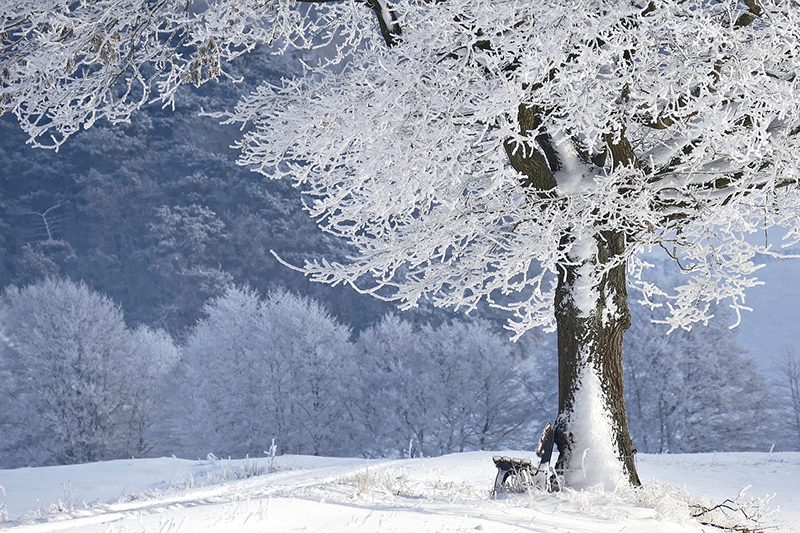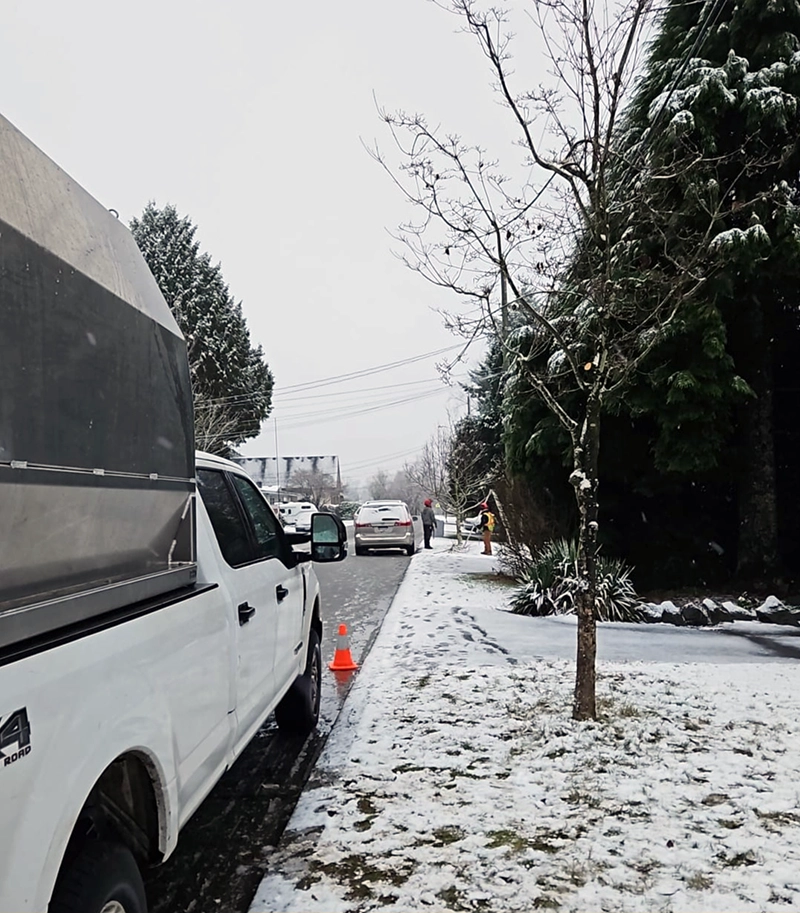Winter in Vancouver means mild temperatures and steady rain, which raises the question: Can you plant trees in Vancouver in winter? The answer is yes, but you must do it right or risk ruining your yard. With guidance from Devine Arboricultural Solutions, winter becomes a good time for your trees to establish strong roots before spring. Curious? We’ll explain why below.

Why Winter Works for Planting Trees
Contrary to most opinions, winter creates ideal conditions for planting trees in Vancouver. Cooler temperatures help trees focus energy on root development rather than leaves. This allows young trees to build strong roots for later growth. The rainy season means you won’t have to water as much. Consistent soil moisture supports root health. The absence of the stress that heat can bring helps newly planted trees settle into their new environment.
Early Advantage: Trees planted in winter experience a growth spurt by early spring, so we consider winter a good time for trees.
Strong Root Development: Trees form healthy roots during winter.
Natural Moisture Supply: Vancouver’s wet season gives ideal soil moisture levels.
Choosing Trees And Shrubs For Winter Planting
Not all trees adapt well to winter planting, so you must pick the right tree for your area. Deciduous trees are best as they focus their energy on root development when dormant. Bare-root trees and container-grown trees are especially suitable for this time of year. Here are some of the best for Vancouver’s Pacific Northwest climate:
- Japanese maples (Acer palmatum)
- Dogwoods
- Cedar and fir varieties
- Young fruit trees, like apple or plum
Evergreen trees also grow well in winter when planted in well-drained soil. Their foliage brings life to small gardens and larger landscapes, even when colder.
Steps for Winter Planting
Want to plant trees in early winter in Vancouver? You have to be ready. Vancouver’s rainy climate often leaves the soil saturated, so you must guarantee a suitable planting site.
Assess Soil Quality
Frozen or waterlogged soil prevents root development. Always check the soil for drainage and avoid places with soil compaction or too much moisture. A simple pH test or even a more in-depth soil analysis can save future heartache from losing a planted tree. Determining the soil profile can help you make the right decision on the species of tree to plant or what you need to do in the way of soil remediation.
Dig Holes in a ‘Dish’ shape
Planting in a ‘Dish’ shaped hole is the optimum way to plant. The diameter of the hole should be three times the diameter of the root ball. Ensure the centre is as deep as the finished rootball after preparing it, and grade the hole outwards towards the extremities. The ‘Dish’ allows for young root development through less dense soil, taking root and stabilizing faster and allowing more accessibility for water and nutrient gathering more quickly.
Use Mulch and Stakes
Protect the base of the tree with mulch. Mulch insulates roots and retains moisture. Stakes also act as stabilizers for the tree trunk in high winds, keeping it upright. Mulch is vital to the establishment of new trees. It regulates water availability to the young tree and breaks down over time to provide essential nutrients, all while keeping competing weeds and eager line trimmers at bay. Ensure the tree stakes are removed after one year of establishment, after checking the stability of the tree. If the tree is still moving in the ground freely, or is at a different aspect from planting, reassess the health of the tree and site conditions.
Water Correctly
Do not overwater your trees, as excessive moisture can damage tree roots. Use a watering bag or drip irrigation system for consistent soil moisture. Watering bags are only necessary during the hottest months, June through September. Install your watering bags around the stakes and rest them on the edge of your mulch ring. This will prevent the root crown from excessive moisture and possible rot, and encourage the outward development of new roots towards the water source.
Overcoming Common Challenges
Winter planting comes with its own set of difficulties, but simple solutions keep your trees safe.
Address frost, wildlife damage, and heavy winds immediately to ensure newly planted trees grow in late winter and beyond.
- Frost Protection: Frost damages small trees, especially their roots and bark. Cover the tree with burlap for insulation. Mulch around the base to regulate soil temperature. Don’t use plastic, which traps moisture and causes rot.
- Prevent Wildlife Damage: Deer and rabbits chew on bark and branches. For protection, use tree guards or mesh fences.
- Secure Against Winds: Winter winds destabilize young trees, risking uprooting. Place stakes at equal distances to allow slight movement, which promotes root establishment without stressing the trunk.
Why Hire Experts for Winter Tree Planting
Devine Arboricultural Solutions knows what it means to plant or care for trees in Vancouver’s local climate. With years of experience, our team provides expert solutions to help your newly planted trees grow as tall as possible and safely.

Services Offered by Devine Arboricultural Solutions
- Tree Plant Support: Our pros will help you choose the best tree and prepare the planting site.
- Arborist Reports: We will assess soil conditions and recommendations for the right species.
- Stump Removal: We clear your yard for new trees and create ideal growing conditions.
- Tree Maintenance: Continuous care to keep trees healthy, like pruning and pest control.
Benefits of Expert Assistance
Want to plant a growing tree or care for mature trees?
It’s just smarter to work with an expert.
Personalized Advice
Every yard is different, and experts can guide your tree projects to your unique conditions. Pros assess soil quality, sunlight, and local climate to recommend the right tree for your space.
Efficient Planting
Planting trees is more than just burying them in a hole. Tree experts make sure the planting site is properly prepared. They can stop long-term problems like soil compaction and promote healthy root flare exposure. They also use techniques that reduce transplant shock and let tree roots establish quickly.
Comprehensive Care
Trees need consistent care to thrive. Arborists provide watering schedules, recommend wood chips to retain soil moisture, and address potential challenges like dry summers. They also monitor for pests, invasive species, and fallen leaves that may harbour disease. Their Maintenance Tips ensure street trees and small gardens remain vibrant, even when the climate fluctuates. By staying updated with the latest news in arboriculture, they prepare trees for long-term success.
Can You Plant Trees In The Winter?
Winter is a chance to think about what you want for your yard. Do you want healthy new trees by spring? Are you ready to give them the care they need to grow? Winter provides the perfect time to act, but licensed arborists make the process even easier. From sowing young trees to improving what you already have, the colder season allows you to plan for a vibrant yard.
Contact Devine Arboricultural Solutions
Tree planting in winter doesn’t have to be complicated.
Devine Arboricultural Solutions offers expert tree care for Vancouver property owners, including assistance and arborist reports.
With help from experienced professionals, you can create an outdoor space that screams green and beautiful.
